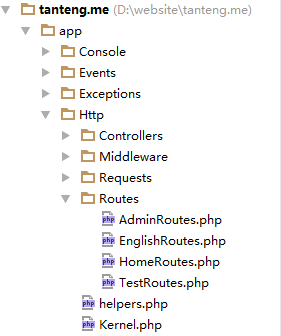Home > Article > Backend Development > The best way to split the routes file (routes.php) in Laravel
本文是一篇关于Laravel分割路由文件(routes.php)的最佳方式教程文章,内容介绍的很详细,学习Laravel的小伙伴可以参考学习。
前言
Laravel 的路由功能很强大,默认都是定义在 routes.php 文件中,随着项目越来越大,我们需要的定义的路由越来越多,想象一下,如果几百上千个路由都定义在一个文件中,如何去维护?也许还有不同的人都在同一个文件定义路由,这就造成了冲突,因此我们需要分割 routes.php 文件。
下面介绍一种很优雅的方式。
在 app/Providers/RouteServiceProvider.php 的 map 方法中可以如下定义:
public function map(Router $router)
{
$router->group(['namespace' => $this->namespace], function ($router) {
//require app_path('Http/routes.php');
foreach (glob(app_path('Http//Routes') . '/*.php') as $file) {
$this->app->make('App\\Http\\Routes\\' . basename($file, '.php'))->map($router);
}
});
}
文件组织结构图如下:

这样它会遍历 app/Http/Routes/ 文件夹下的文件,遍历每个文件路由类的 map 方法,每个文件的结构都类似,
举个例子:
<?php
/**
* Created by PhpStorm.
* User: xl
* Date: 2016/7/4
* Time: 18:07
*/
namespace App\Http\Routes;
use Illuminate\Contracts\Routing\Registrar;
class HomeRoutes
{
public function map(Registrar $router)
{
$router->group(['domain' => 'www.tanteng.me', 'middleware' => 'web'], function ($router) {
$router->auth();
$router->get('/', ['as' => 'home', 'uses' => 'IndexController@index']);
$router->get('/blog', ['as' => 'index.blog', 'uses' => 'BlogController@index']);
$router->get('/resume', ['as' => 'index.resume', 'uses' => 'IndexController@resume']);
$router->get('/post', ['name' => 'post.show', 'uses' => 'ArticleController@show']);
$router->get('/contact', ['as' => 'index.contact', 'uses' => 'IndexController@contact']);
$router->post('/contact/comment', ['uses' => 'IndexController@postComment']);
$router->get('/travel', ['as' => 'index.travel', 'uses' => 'TravelController@index']);
$router->get('/travel/latest', ['as' => 'travel.latest', 'uses' => 'TravelController@latest']);
$router->get('/travel/{destination}/list', ['as' => 'travel.destination', 'uses' => 'TravelController@travelList']);
$router->get('/travel/{slug}', ['uses' => 'TravelController@travelDetail']);
$router->get('/sitemap.xml', ['as' => 'index.sitemap', 'uses' => 'IndexController@sitemap']);
});
}
}
把路由规则都写到每个文件的 map 方法中,这样一来,就实现了很好的 routes.php 文件的分开管理。此外,你也可以简单的分割,直接把 routes.php 中的定义拆散成多个文件,通过 require 的方式引入,但是哪个更好,一目了然。
那么这样路由分开多个文件后岂不是增加调用次数,会不会影响性能?答案是不必担心。通过 Laravel 的命令:
php artisan route:cache
生成路由缓存文件后,路由只会读取缓存文件的路由规则,因此不会影响性能,这样做让开发更高效和规范。
好了,以上就是Laravel路由文件(routes.php)最佳分割方式的全部内容,希望对大家学习Laravel有所帮助。也希望大家多多支持PHP中文网。
更多The best way to split the routes file (routes.php) in Laravel相关文章请关注PHP中文网!